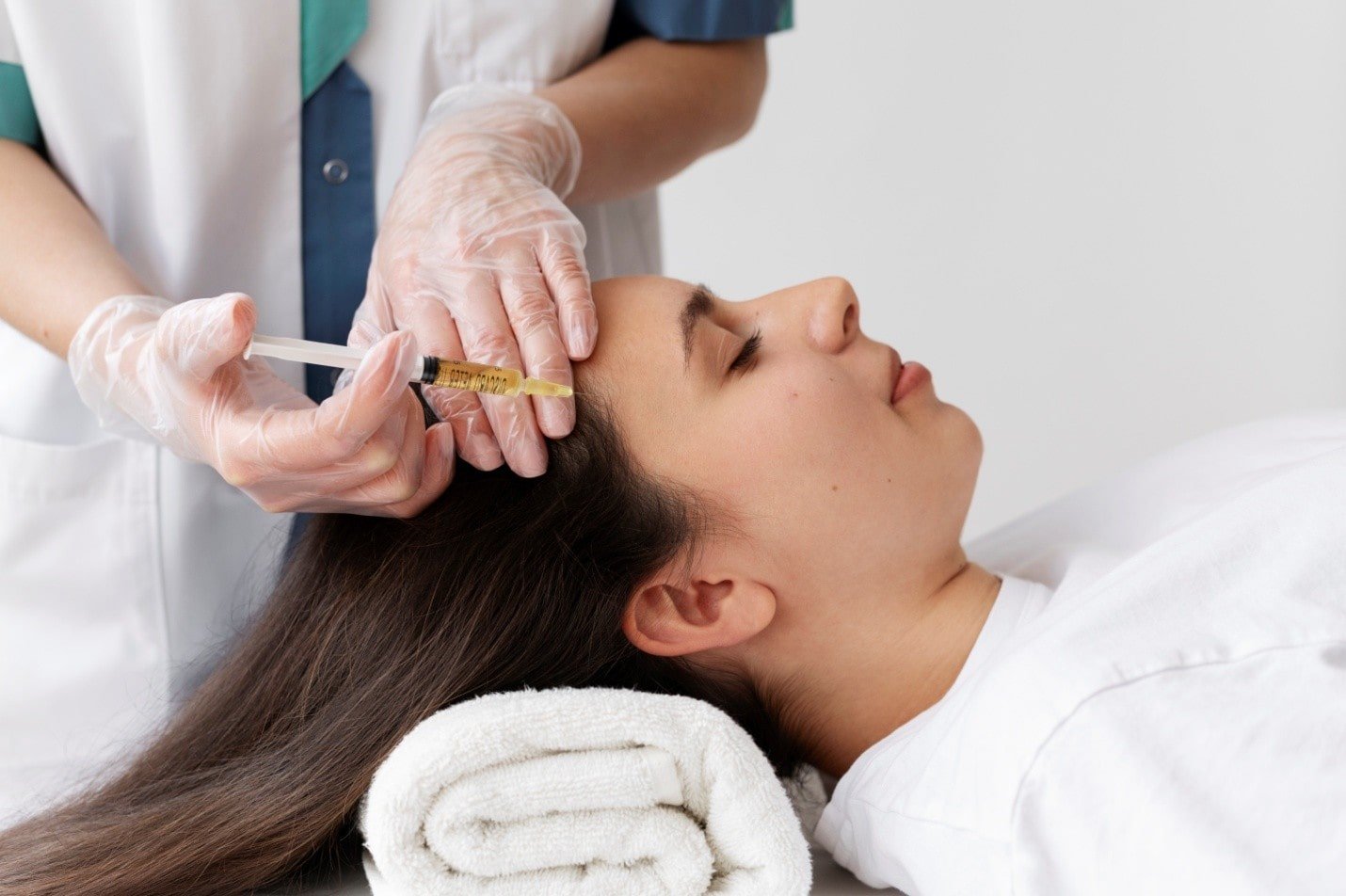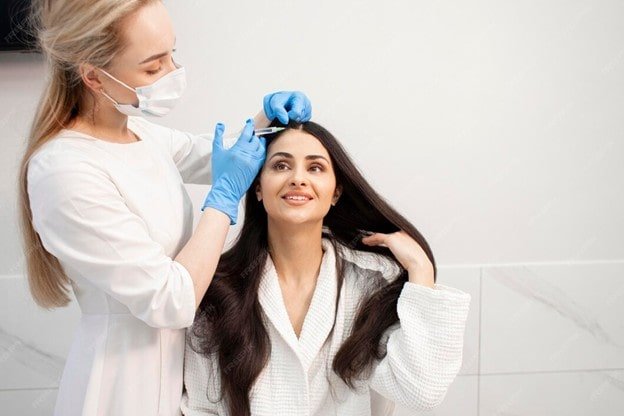How PRP Therapy Works to Promote Hair Growth Naturally
Hair loss can be a distressing experience, affecting both appearance and self-confidence. Whether it’s due to genetics, hormonal changes, stress, or environmental factors, thinning hair and bald patches can make anyone feel self-conscious. While there are many treatments available to address hair loss, not all are natural or long-lasting. One of the most revolutionary, minimally invasive, and natural solutions today is PRP therapy, short for Platelet-Rich Plasma therapy.
PRP therapy uses the body’s own healing abilities to stimulate dormant hair follicles, encouraging them to grow stronger and thicker hair. Unlike treatments that rely on chemicals or surgery, PRP takes a holistic approach, making it an appealing choice for people seeking a safe, effective, and natural way to restore their hair.
In this blog, we’ll explore what PRP therapy is, how it works to promote hair growth, its benefits, and why it has become one of the most trusted non-surgical solutions for hair restoration.


Understanding PRP Therapy
PRP therapy is a medical procedure that involves using the platelet-rich plasma from your own blood to trigger tissue repair and regeneration. Platelets are components of the blood that play a vital role in healing wounds and stimulating growth. They contain proteins known as growth factors, which are essential for repairing damaged cells and encouraging the development of new tissue.
In the context of hair loss, these growth factors can reactivate dormant hair follicles and improve the health of existing ones. By directly delivering these powerful natural elements to the scalp, PRP therapy enhances the body’s ability to produce stronger, thicker, and healthier hair strands.
Originally used in sports medicine and injury recovery, PRP has gained significant popularity in dermatology and cosmetic medicine due to its regenerative properties. Today, it’s one of the leading treatments for conditions like androgenic alopecia (pattern baldness) and other types of hair thinning.
How PRP Therapy Works Step-by-Step
The process of PRP therapy is straightforward, safe, and minimally invasive. Here’s how it works in simple steps:
Step 1: Blood Collection
The procedure begins with a small blood draw, similar to a routine blood test. Typically, the blood is taken from the arm.
Step 2: Centrifugation
The collected blood is placed in a centrifuge, a specialized machine that spins at high speed. This process separates the blood into different components:
- Red blood cells
- Plasma (the liquid portion of the blood)
- Platelet-rich plasma, which contains concentrated growth factors
The PRP is then extracted carefully for use in the treatment.
Step 3: Scalp Preparation
The scalp is cleaned thoroughly to ensure a sterile environment. In some cases, a numbing cream or local anesthetic may be applied to minimize discomfort.
Step 4: PRP Injection
The concentrated PRP solution is injected directly into areas of the scalp experiencing thinning or hair loss. These injections are placed at strategic points to target the hair follicles effectively.
Step 5: Healing and Hair Growth Stimulation
Once injected, the growth factors in PRP stimulate cellular repair and regeneration, improving blood supply to the follicles and encouraging new hair growth over time.
The entire procedure usually takes about 45–60 minutes and requires little to no downtime, making it easy to fit into a busy schedule.
The Science Behind PRP for Hair Growth
To understand why PRP therapy is effective, it helps to know how hair grows. Hair follicles go through three phases:
- Anagen Phase (Growth): The active phase where hair grows continuously.
- Catagen Phase (Transition): A short transitional phase where growth slows.
- Telogen Phase (Resting): The follicle rests, and hair eventually falls out before new growth begins.
In cases of hair loss, many follicles get stuck in the telogen phase, resulting in thinning and baldness. The growth factors in PRP work by:
- Reactivating follicles that are dormant.
- Extending the anagen (growth) phase.
- Improving blood circulation to the scalp, delivering nutrients to follicles.
- Reducing inflammation that may be contributing to hair loss.
Essentially, PRP therapy creates a healthy environment for natural hair growth, addressing hair loss at its root cause rather than just treating surface symptoms.
Benefits of PRP Therapy for Hair Growth
PRP therapy offers several advantages that make it a preferred choice for people experiencing hair loss.
1. Natural and Safe
Since PRP uses your own blood, there’s no risk of allergic reactions or foreign substances entering your body. It’s a natural approach to hair restoration.
2. Minimally Invasive
Unlike surgical procedures like hair transplants, PRP involves only injections, making it far less invasive and requiring minimal recovery time.
3. Stimulates Natural Growth
The treatment works by reactivating your body’s own processes, resulting in hair that looks completely natural.
4. Effective for Various Hair Loss Conditions
PRP is effective for treating:
- Male and female pattern baldness (androgenic alopecia)
- Postpartum hair loss
- Hair thinning due to stress or hormonal imbalance
- Weak, brittle hair prone to breakage
5. Minimal Downtime
Patients can typically resume their daily activities right after the session, with only mild redness or tenderness that fades quickly.
6. Complements Other Treatments
PRP can be combined with other hair loss treatments such as topical medications or microneedling to enhance results.
Who Can Benefit from PRP Therapy?
PRP therapy is suitable for a wide range of individuals, but the ideal candidates include:
- People in the early stages of hair thinning or mild baldness.
- Those with thinning hair but active hair follicles.
- Individuals seeking a natural, non-surgical solution for hair restoration.
- Patients looking to improve hair density and strength after childbirth or illness.
- Men and women experiencing stress-related hair shedding.
However, it may not be as effective for those with complete baldness, as there may not be enough active follicles to stimulate.
What to Expect After PRP Therapy
While some people notice improvements within the first few weeks, hair growth is a gradual process. Here’s a general timeline of what you can expect:
- First 1–2 weeks: Mild shedding may occur as older hairs make way for new growth.
- 1–3 months: Hair shedding decreases, and new baby hairs start to appear.
- 3–6 months: Noticeable improvement in hair thickness and density.
- 6–12 months: Significant, long-lasting results with consistent treatments.
For optimal results, most professionals recommend 3–4 initial sessions spaced a few weeks apart, followed by maintenance treatments every 4–6 months.
Tips to Maximize PRP Results
To get the best results from PRP therapy, consider these simple yet effective tips:
- Follow a healthy diet rich in protein, iron, and vitamins like biotin to support hair health.
- Avoid smoking and excessive alcohol consumption, as they can affect blood circulation.
- Stay consistent with treatment sessions and follow-up appointments.
- Use gentle hair care products free from harsh chemicals.
- Protect your scalp from sun exposure by wearing hats or using sunscreen.
Myths and Misconceptions About PRP Therapy
PRP therapy is surrounded by several myths that can cause confusion. Let’s debunk some of the most common ones:
Myth 1: PRP is painful
Truth: While there may be slight discomfort during injections, most people tolerate the procedure well. Numbing creams are often used to minimize pain.
Myth 2: Results are instant
Truth: Hair growth takes time. Results typically become noticeable after a few months of consistent treatments.
Myth 3: PRP is only for men
Truth: PRP is effective for both men and women experiencing hair thinning or loss.
Myth 4: It works for everyone equally
Truth: While highly effective, results may vary depending on factors like age, the extent of hair loss, and overall health.
Why PRP Therapy Stands Out Among Hair Loss Solutions
There are many treatments for hair loss, such as topical medications, laser therapy, and hair transplant surgery. However, PRP stands out for several reasons:
- It uses your body’s natural healing process, making it safe and biocompatible.
- The treatment is non-surgical and has minimal downtime.
- Results look completely natural, without the artificial appearance that some other solutions may cause.
- It targets hair loss at its root, improving scalp health and follicle function.
Final Thoughts
Hair loss doesn’t have to be a permanent condition. With PRP therapy, you can harness the healing power of your own body to regrow and strengthen your hair naturally. This treatment not only addresses hair thinning but also improves overall scalp health, creating the ideal environment for healthy, long-term growth.
By understanding how PRP works and staying consistent with treatments, you can regain a thicker, fuller head of hair and the confidence that comes with it. For anyone seeking a safe, natural, and effective solution, PRP therapy is an excellent option to explore.

